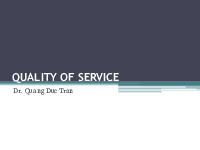



















Preview text:
DIGITIALIZATION PRINCIPLES Dr. Quang Duc Tran Analog Signals
• As mentioned earlier the amplitude of the signal varies continuously with time
• The Fourier transform decomposes a signal into the frequencies that make it up
• The Fourier analysis can be used to show that any time
varying signal is made up of infinite number of single-
frequency sinusoidal components. Analog Signals (Cont.)
• A band-limited signal x(t) is one whose Fourier
Transform is non-zero on only a finite interval of the frequency axis.
• There exists a positive number B such that X(f) is non-
zero only in -B≤f≤B. B is called the signal bandwidth.
• Speech bandwidth: 100Hz – 4kHz
• Music Bandwidth: 15Hz – 20kHz
• To transmit an analogue signal through a network the
bandwidth of the transmission channel should be equal
to or greater than the signal bandwidth. Digital Audio Recording Chain Analog-to-Digital Digital-to-Analog Conversion Conversion Input Filter Low-pass Smoothing Filter Digital Audio Recording Chain Fourier Transform
• The Fourier Transform is an operation that transforms
data from the time domain into the frequency domain. • Forward Fourier Transform: ∞
𝑋(𝑤) = න 𝑥(𝑡)𝑒−𝑗𝑤𝑡𝑑𝑡 −∞ • Inverse Fourier Transform: 1 ∞ 𝑥(𝑡) =
න 𝑋(𝑤)𝑒𝑗𝑤𝑡𝑑𝑤 2𝜋 −∞ Fourier Transform (Cont.)
• What frequencies are present in the signal and in what
proportions. The Fourier Transform decomposes a
waveform into sinusoids. Waveforms are not made up of
a discrete number of frequencies, but rather a
continuous range of frequencies. SAMPLING Dr. Quang Duc Tran Sampling (Signal Processing)
• In signal process, sampling is a reduction of a
continuous-time signal to a discrete-time signal. The sampling frequency or
sampling rate (i.e., fs) is the average number of samples obtained in one second. Sampling Rate
• Nyquist theorem: If x(t) is a band-limited signal
containing no frequencies higher than B. A sufficient
sampling rate (i.e., fs) is 2B or anything larger. 2B is called the Nyquist rate.
• Nyquist rate is represented either in Hz or more
correctly in samples per seconds Sampling Rate (Cont.)
Ts = Sampling period 1 𝑆(𝑤) = [𝑋 𝑤 ∗ 𝐶 𝑤 ] 2𝜋 1 ∞ 𝑆(𝑤) = [𝑋 𝑤 ∗ 𝑤 𝛿(𝑤 − 𝑛𝑤 2𝜋 𝑠 𝑠)] 𝑛=−∞ 1 ∞ 𝑆(𝑤) = [𝑋 𝑤 ∗ 𝛿(𝑤 − 𝑛𝑤 𝑇 𝑠)] 𝑠 𝑛=−∞ 1 ∞ 𝑆(𝑤) = [ 𝑋(𝑤 − 𝑛𝑤𝑠)] -4T 𝑇 s -3Ts -2Ts -Ts 0 Ts 2Ts 3Ts 4Ts 𝑠 𝑛=−∞ Sampling Rate (Cont.)
• For a band-limited signal (X(f) = 0 for all |f|≥B), and fs≥2B, it is
possible for the copies to remain distinct from each other. But when the
Nyquist criterion is not satisfied, adjacent copies overlap. Any frequency
component above fs/2 is indistinguishable from a lower-frequency
component, called an alias. Sampling Rate (Cont.) QUANTIZATION Dr. Quang Duc Tran Data Representation
• The most significant bit of the codeword represents the sign of the sample.
• A binary 0 indicates a positive value and a binary 1
indicates a negative value.
• The signal must be sampled at a much higher rate than
the maximum rate of change of the signal amplitude.
• The number of quantization levels should be as large as
possible to represent the signal accurately Quantization
• Quantization is the process of mapping an analogue value to a number of digits
• Three bits are used to represent each sample (1 bit for
the sign and two bits to represent the magnitude)
If Vmax is the maximum positive and
negative signal amplitude and n is the
number of binary bits used then the
quantization interval, q, is defined as q = Vmax/2n Quantization Error Each sample is rounded off to closest available level and then converted to its correspondence PCM code. Quantization Error (Cont.)
• Quantization error is the difference between the actual
signal amplitude and the corresponding nominal
amplitude. Consequently, a difference of q/2 from the
actual signal level is present. Quantization error is also
known as quantization noise since values vary randomly SQNR = 6.02 x n (dB)
SQNR = 1.761+ 6.02 x n (dB) SNR and Audio Bit Depth #bits SQNR Possible integer values 4 24 dB 16 8 48 dB 256 11 66 dB 2048 12 72 dB 4096 16 96 dB 65.536 18 108 dB 262.144 20 120 dB 1.048.576 24 144 dB 16.777.216 32 192 dB 4.294.967.296
ENCODER AND DECODER DESIGN Dr. Quang Duc Tran




